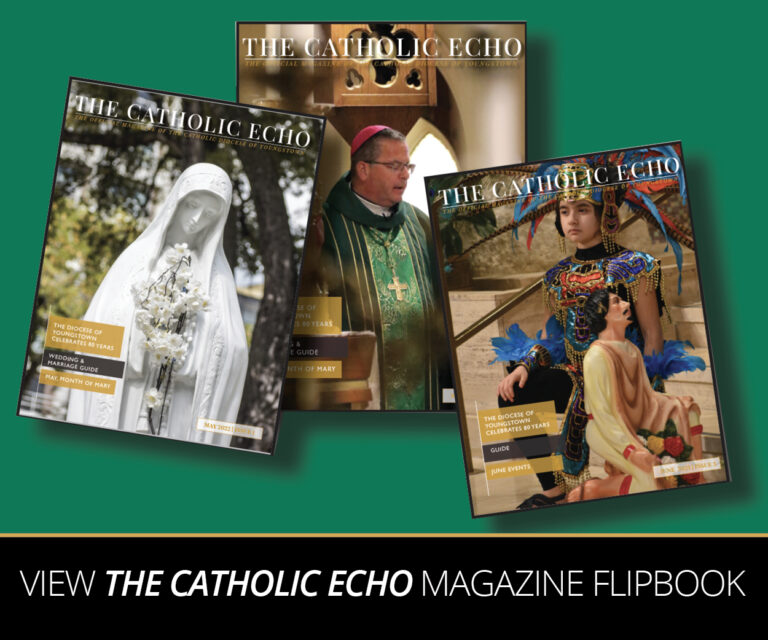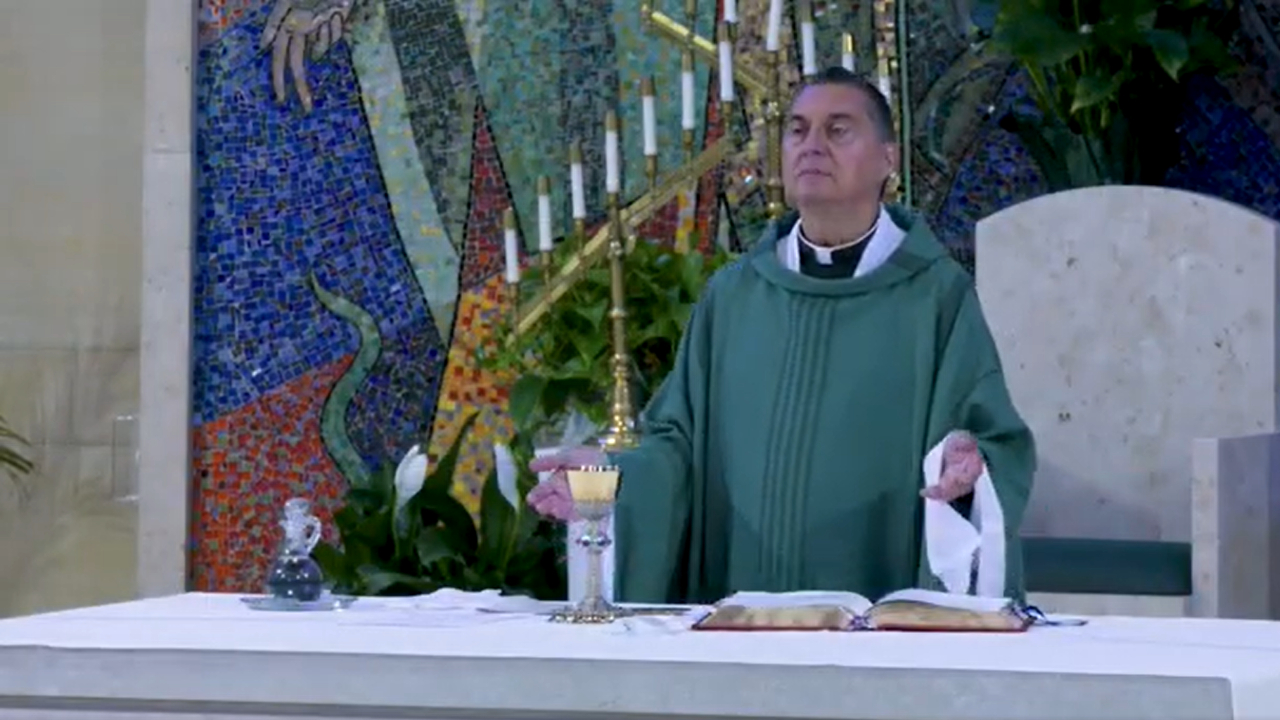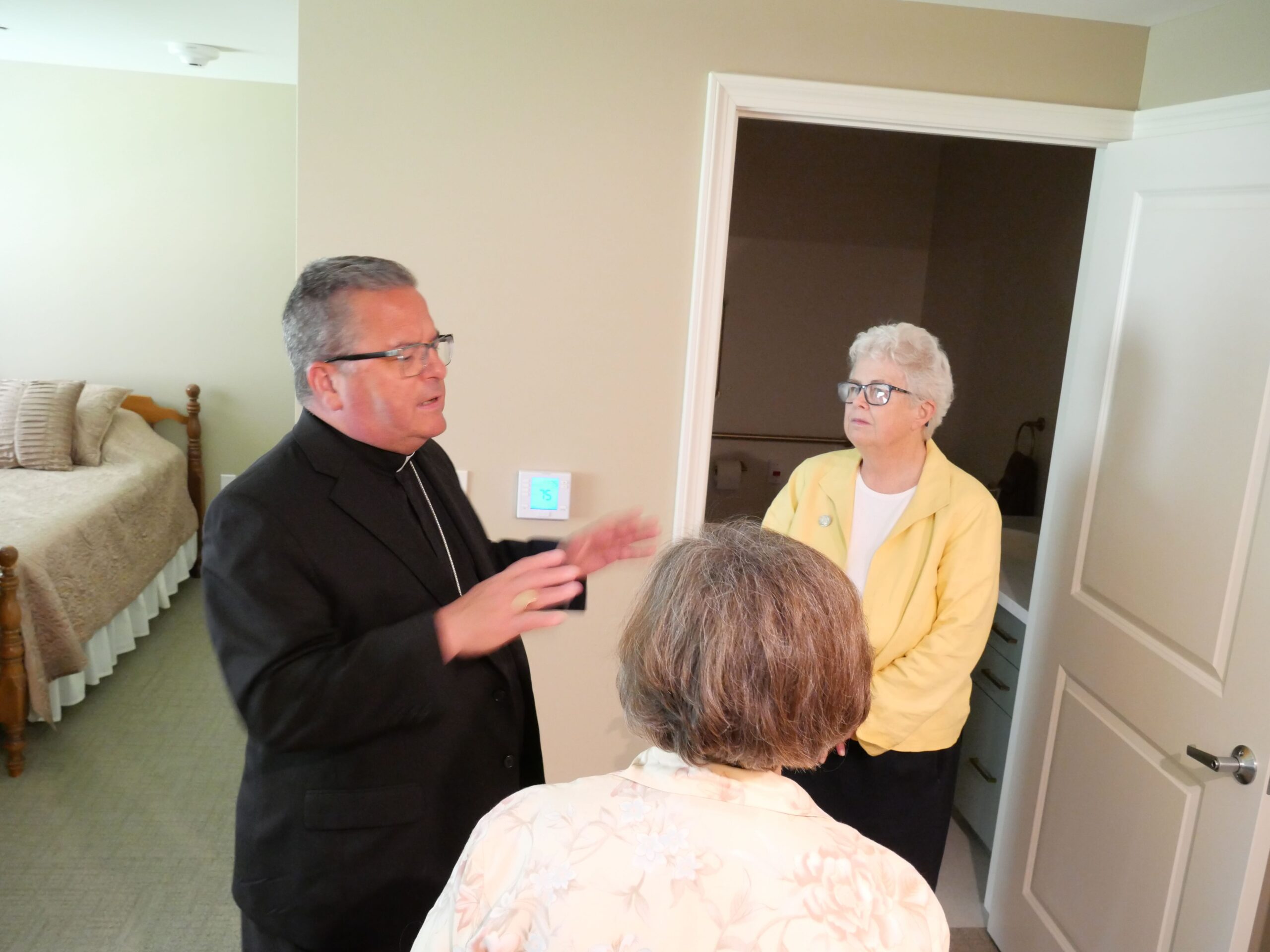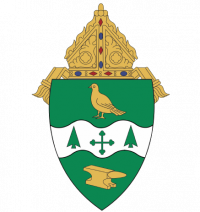When a church in the Diocese of Youngstown closes its doors for the final time, what happens to all the things inside?

One of the first things Bishop David Bonnar did when arriving in the Youngstown Diocese early in 2021 was to establish the Office of Patrimony, which is responsible for the safekeeping, maintenance and dispensation of items from closed churches.
He chose Father David Misbrener, pastor of St. Jude Parish in Columbiana and Our Lady of Lourdes Parish in East Palestine, as the office’s director.
“He loves the Church, but also has an affinity for the history of the diocese as well as individual churches and the artifacts that accompany them,” Bishop Bonnar said of Father Misbrener. “He has my utmost confidence and I am pleased with his efforts so far.”
Father Misbrener said he was chosen for the role thanks to his fellow priests.
“The Bishop had approached some of the priests and asked them who was interested in the history of the diocese. All their hands pointed to me,” he said, noting that his academic background is in history.
Father Misbrener explained that when a church building closes, its “temporal goods,” such as altars, statues, chalices, ciboria, stained glass windows, bells and Stations of the Cross, are assumed by its parish, to be used in the parish’s remaining church buildings.
If the parish does not have a need for the items, Father Misbrener contacts priests within the diocese to let them know what is available.
Bishop Bonnar notes, “We want to keep our sacred items in the family, so to speak, so that they continue to inspire the faith of the people of our diocese, our diocesan family.” Through Father Misbrener’s office, priests in the diocese can request the items for their parish, for a monetary donation. The donation goes back to the parish from which the items came.
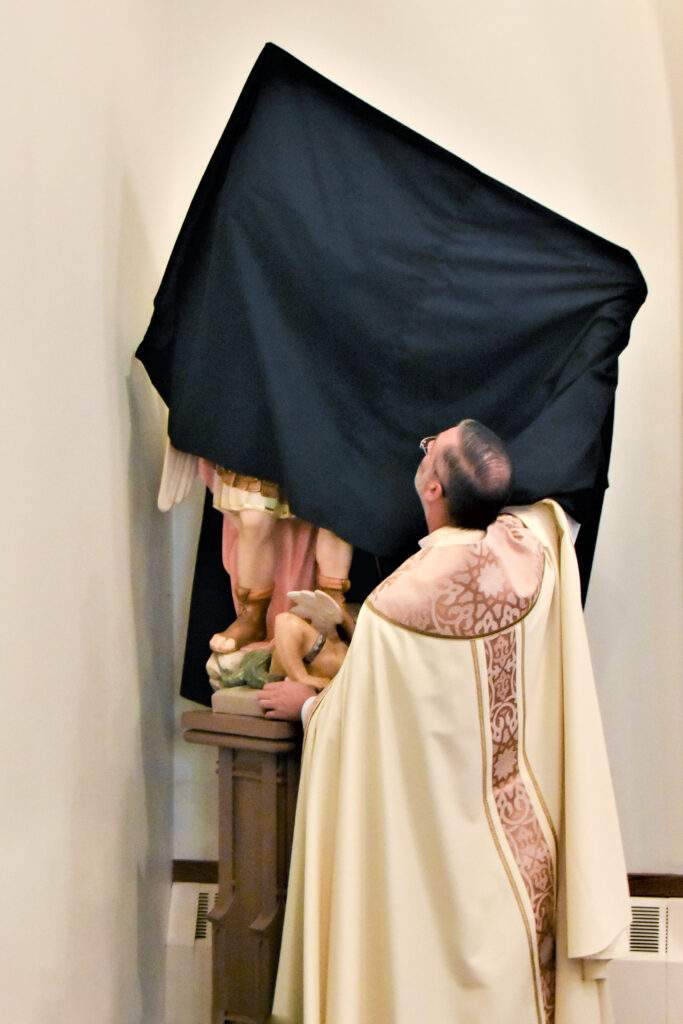
The items are not just given away, and they cannot be sold to a lay person or for or any non-ecclesial use. If a family donates a temporal good to a church, they do not get it back when the church closes. If the parish relinquishes the item, it becomes the property of the diocese, Father Misbrener said.
He said if no diocesan parishes have a need for an item from a closed church, he contacts Henninger’s in Cleveland, a “fourth-generation, family-owned business committed to serving the Church and clergy,” according to its website.
“They take great care in removing altars, stained glass windows and marble structures, and either storing them for future use by the diocese or restoring them.” Father Misbrener said that through its website, “Henninger’s distributes items all over the United States and there is a big demand for stained glass windows and Stations of the Cross.”
He explained that smaller items, such as plaques, pictures and historical items, are given to diocesan archivist and chancellor Joan Lawson. Lawson said her role is to “collect, preserve and make available the history of the diocese,” which turns 80 this year.
In announcing her appointment as archivist last year, Bishop Bonnar said, “We need to give joyful witness to our history. It has been my dream since I arrived to establish a diocesan archives. In fact, it is necessary and obligatory for every diocese. Joan is the perfect person to lead our efforts to care for and document our history. With her experience and training in both history and ministry, she will help us dream of new ways to tell our story and build on that story as we live the mission of the Church.”
Father Misbrener said holy items should not be for sale at antique stores and garage sales, and even the smaller items should be donated to the diocesan Missions Office, which restores these items and ships them to missionaries around the world. You can read more about this office and its director, Father Edward Brienz, in a future issue of The Catholic Echo.
Monsignor John Zuraw, diocesan vicar general, said Book Five of the Code of Canon Law, titled “Temporal Goods of the Church,” is all about stewardship and accountability, noting that the bishop and diocesan priests are “the stewards of the goods, the properties are entrusted to them and they are held responsible for their safekeeping, maintenance and disposition.”
He explained that temporal goods, in contrast to spiritual goods, are those that have economic value.
Monsignor Zuraw explained that, over the last several years, many of the diocese’s church buildings have closed. He said, “Working with the church’s pastor, Father Misbrener and Joan Lawson, items from these churches that are closed need to be kept safe, maintained or maybe used in other church buildings.” Monsignor Zuraw continued, “The Office of Patrimony was created to carry out the norms of Canon Law on accountability and stewardship. Before the creation of this office, care was given to ensure that all items were kept safe and not ending up at antique stores. Father Misbrener and Joan Lawson are using their skills and knowledge to carry out the vision and mission of Book Five of the Code of Canon Law.”
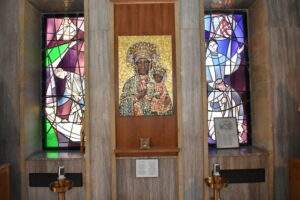
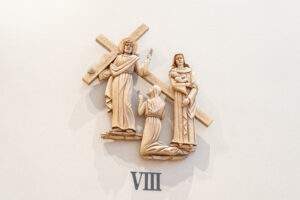
Father Misbrener said St. Stanislaus Kostka Church on Youngstown’s South Side was the largest church he had to clean out since being named director of the Office of Patrimony. The parish was canonically suppressed on December 12, 2021, after celebrating its final Sunday Mass in June of 2020.
He said no other parishes claimed the church’s pipe organ, so he contacted a company that sells organs and they took it. St. Columba Cathedral accepted the chalices and monstrances from the church because it was the receiving parish, since many of St. Stanislaus Kostka parishioners began attending St. Columba.
Father Misbrener said the church had a brand-new sound system that ended up going to Holy Family Parish in Navarre, which itself was the result of a merger between St. Therese in Brewster and St. Clement in Navarre.
Lawson said the archives took possession of the following: St. Stanislaus Kostka Parish’s church records, a statue of the church’s namesake and a 1938 trophy from the church’s baseball team, which won a championship. She said her office is using a closed church in Youngstown as a storage facility. Lawson also noted that archivists at Kent State University store records from the diocese from 1943 through 1978 at an off-site facility, while records from 1978 until the present are stored in the diocesan archives.
Father John-Michael Lavelle, pastor of St. Michael Church in Canfield, plans to obtain the stained-glass windows from the former St. Joseph the Provider Church in Campbell, which was one of three church buildings for Christ the Good Shepherd Parish, along with St. Lucy and St. John the Baptist. Christ the Good Shepherd Parish was created in 2012 out of a merger of those three communities, along with St. Rosa de Lima Parish. Since 2021, Christ the Good Shepherd has had one worship site, at St. John the Baptist Church.
Father Misbrener said the altars and stained-glass windows still need to be removed from St. Lucy. He also said the three bells that were in the bell tower at St. Joseph the Provider, which he called “magnificent,” are being used in another diocese.
Father Michael Swierz, pastor of St. Patrick Parish in Hubbard, was the pastor of the former St. Joseph Parish for many years, and he acquired the church’s crucifix for St. Patrick because some of the Campbell parishioners followed him to Hubbard.
“It is being refinished at Henninger’s to match the rest of the wood we have at St. Pat’s,” Father Swierz said. “I think it will be very comforting for the parishioners who came from St. Joseph the Provider to see their crucifix here.”
He said he worked directly with Father James Korda, who was administrator for Christ the Good Shepherd Parish at the time, to arrange a donation.
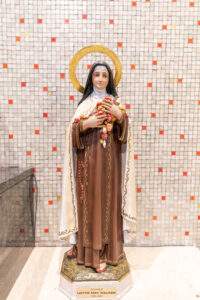
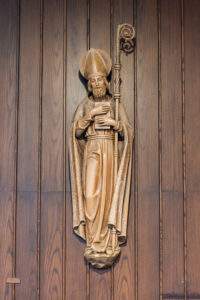
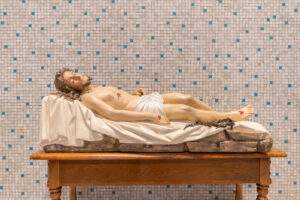
Father Martin Celuch, pastor of Our Lady of the Holy Rosary in Lowellville and Holy Family Parish in Poland, said he acquired Stations of the Cross from Sts. Cyril and Methodius Church in Warren, which closed last year. He said they were installed just before Lent and he made arrangements directly with Father Christopher Cicero, pastor of St. Elizabeth Ann Seton Parish, and also Blessed Sacrament and St. Mary and Joseph Parishes, in Warren.
Father Cicero explained that St. Elizabeth Ann Seton Parish in Warren was created by the merger of Sts. Cyril and Methodius and St. James. When the Sts. Cyril and Methodius campus was closed, many sacred items were installed at the St. James site to commemorate St. Cyril’s and beautify the church.
In a letter to Sts. Cyril and Methodius parishioners announcing the closing, Bishop Bonnar wrote, “It is always sad when a church building closes because it holds so many memories. One of my responsibilities as bishop is to ensure that our history is preserved and artifacts are treated with reverence and respect. Accordingly, I have directed our diocesan Office of Patrimony to catalogue and preserve sacred objects from Sts. Cyril and Methodius Church and work with Father Cicero to determine an appropriate use.”
Father Cicero said the following items from Sts. Cyril and Methodius were installed at St. James: statues of St. Cyril, St. Methodius, St. Elizabeth Ann Seton, St. Jude, St. Therese of Lisieux and Christ, wall bells, Sanctus bells, a flag of Slovakia, a flag of the United States, a Papal flag, a missal stand, chalices, ciboria, votive candles, a portrait of Sts. Cyril & Methodius Church and a scroll commemorating the dedication of the church.
“Other parishes obtained some items, such as the Stations of the Cross by Holy Family in Poland, the celebrant’s chair by St. Mary in Orwell and candle sticks by St. Elizabeth Ann Seton in Pickerington, Ohio. “We are very happy that these items continue to serve the Church,” Father Cicero said.
Father Misbrener said that when Immaculate Conception Church on Youngstown’s east side closed years ago, many of the items went to St. Angela Merici Parish, which was the result of a merger between Immaculate Conception and Sacred Heart, which is the merged parish’s location. However, the “high altars” from Immaculate Conception are now being used at the Newman Center in Lincoln, Nebraska.
“One of the things we always need to be mindful of as priests, and myself as bishop, is stewardship,” said Bishop Bonnar. “When a church closes, it is important to move these items into storage or donate them to other churches. The Office of Patrimony complements the archives office to ensure that the Church never loses its history and its story continues to be told.”


